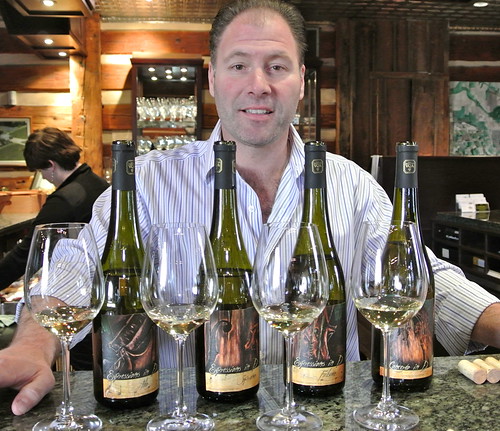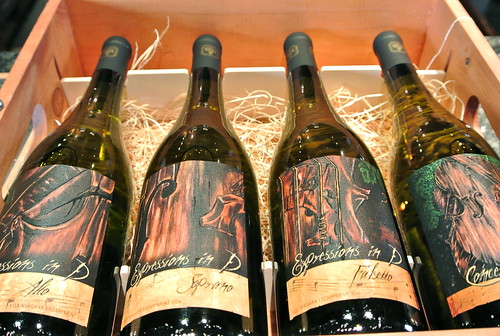
It is one of Niagara’s most famous and most expressive vineyards. If you have visited Vineland Estates Winery you have passed it many times as you drive up the laneway to the main buildings.
And within that St. Urban Vineyard, nestled on the northern edge of the property and bordered to the west by the laneway and east by the lowest watershed trough, is “Field D.”
It is here that Vineland’s top Rieslings are born. Rieslings that have personality; Rieslings that have distinct flavours capable of stirring the soul vintage after vintage.
Vineland makes different Rieslings in any given vintage but chose to lay bare the terroir of this particular part of the vineyard that also consists of Fields A to C.
Winemaker Brian Schmidt decided in 2009 to exploit the unique features within Field D by creating four different Rieslings from three parcels (the fourth one is a combination of the three) divided by east, centre and west plantings.

He would call his project the Expressions in D Riesling Series. It is being unveiled this weekend at the winery where you can taste these fascinating wines and buy them either separately ($30 each) or as an attractive package in a wooden box with a book explaining the wines and special poster of the original art created by in-house graphic artist Melissa Proudlock ($135).
If you are a Riesling freak like I am, you will love this experiment.
The wines all have this in common:
• Same Weis 21B close
• Same field within the vineyard all grown within meters of each other
• Limestone and clay base
• Same pruning, tying, canopy and soil management
• All picked on the same day
• Same winemaking (crushing, fermenting, clarifying, bottling and aging)
• Brix were close but not the same in all three wines
• Acidity was similar in all three wines
• Residual sugar was within five points of each other
• Same yeast used in fermentation
So what differentiates these wines? And, trust me, there are profound differences in each bottle.
As Schmidt explains, the base is the same (limestone/clay) but the 15 inches of topsoil differs in the field as you travel west to east. On the western slope, gravel defines the top layer of soil, with the centre consisting of sandy soil and the eastern portion defined by loam.
He picked and vinified the three different parcels in Field D separately and bottled the wines with an attractive label designed by Proudlock. The fourth wine is a blend (one-third each of the three wines).

Schmidt said that right from the beginning the parcels showed stark differences, which he attributes directly to the top soil found in each parcel.
He knew that he had to bottle them separately for this unique Riesling project.
“We are thrilled to be able to demonstrate the nuances of terroir through the unique nature of Field D in our St. Urban Vineyard,” he says in the presentation book included when you buy the box set.
“Our place has a voice that is translated through the vines and the specific, subtle whispers have yielded Expressions in D. More than great wine, this is a great opportunity to open up a discussion.”
Schmidt is a master Riesling maker and consistently makes some of Niagara’s finest examples from his entry level to the top reserves made only when he thinks it is worthy. His wines have stood the test of time, which, he believes, Riesling needs to fully express itself.

“I believe the effects of Riesling shows itself after one or two years in bottle. I think we should all be drinking older Rieslings,” he says. He has made it his mission to elevate Riesling beyond a “refreshing summer wine” to a wine with complexity and depth.
He says the Expressions in D project “gives you an understanding of the art of the possible” and, ultimately, “the art of the blend.”
The design and naming of the wine, Expressions in D, is “both literal and figurative at the same time since we often think of the taste of wines in musical terms.”
The three wines were named Alto, Soprano and Falsetto with the blend called Concerto.
The original artwork for the label, created by Proudlock, features a cello emerging from and made of old Riesling vines. A closer look at the art and you can see the vineyard catch wires used as cello strings and two soil types (gravel to the left and loam to the right) on either side of the cello.
The art was “cut” into three to create the three different labels. Set the bottles side by side and the full image of the cello emerges.
It’s really quite attractive and tells a story in itself.
I had the opportunity to try the wines side by side with Schmidt this week. Here is my impression of these very impressive wines.

Vineland Estate Alto Riesling 2009 ($30, 92 points) — From the west block with topsoil consisting of gavel, this is the most expressive wine, the early bloomer, and the most attractive of the four wines out of the gate. The nose is vibrant and soaked in all manner of citrus fruit with just a touch of green apple and petrol beginning to emerge. It is marked by high tension on the palate with ripe citrus balanced on a razor sharp beam of acidity. Enthralling from sip to swallow.
Vineland Estate Soprano Riesling 2009 ($30, 91 points) — I call this one, grown on sandy soil, “the wall flower” — it’s a little shy at the moment but promises to explode if you listen to the palate. The nose is tighter than the other two with shades of pear, citrus, apple and a lovely floral/mineral note emerging. It sheds a lot of that shyness on the palate with tremendous fruit power, racy acidity and laced with stony minerality. A silent beauty waiting to spread her wings if you give it time.
Vineland Estate Falsetto Riesling 2009 ($30, 93 points) — Best described as “the tweener,” this eastern block Riesling grown in loamy soil has a wonderful and expressive nose of grapefruit, tropical fruits, summer apples and drenched in minerality. The lush fruit on the palate is harmonious and rides a firm beam of acidity with a supporting note of ginger spice. It’s in the finish, which lasts over a minute, that a find the impetus for what I think will be the longest-lived wine of the three. Sensational Riesling.
Vineland Estate Concerto Riesling 2009 ($30, 92 points) — Bringing, obviously, all the elements of the above, with a nose of citrus, apples, minerals and subtle peach and pear notes. It’s refreshing, lifted by mouth-awakening acidity, and a showcase for the St. Urban Vineyard. Even though it’s already nicely aged for you, if you give it time, a sweet petrol note should add complexity over time.
Note: There are 170 cases of each wine available.






Comment here